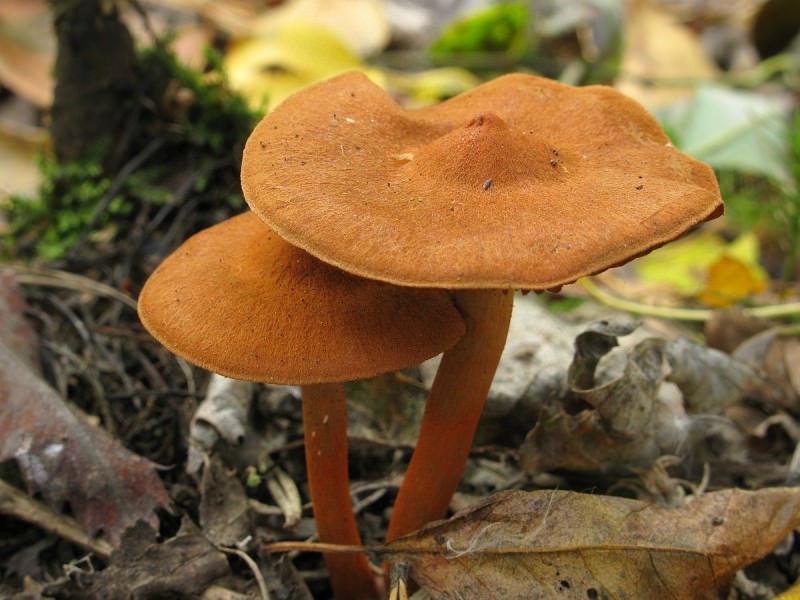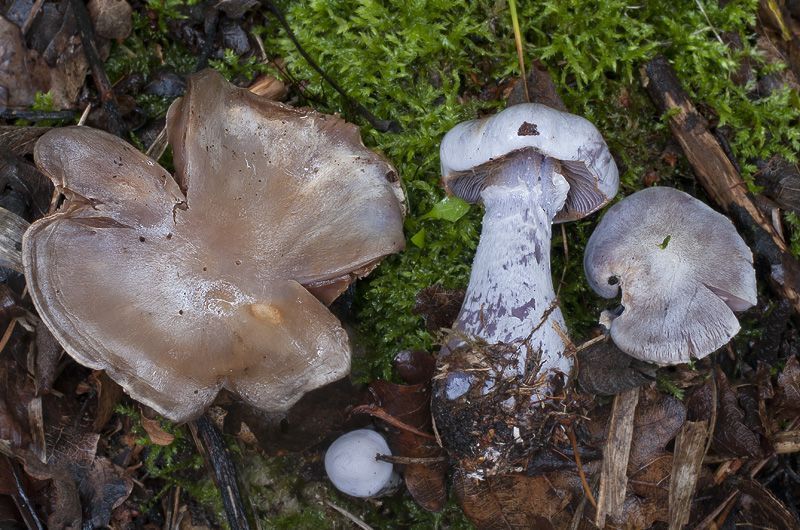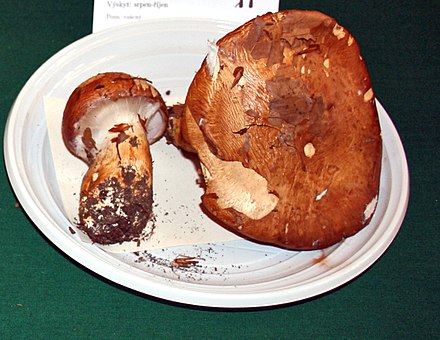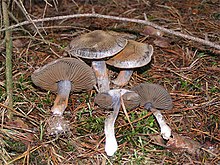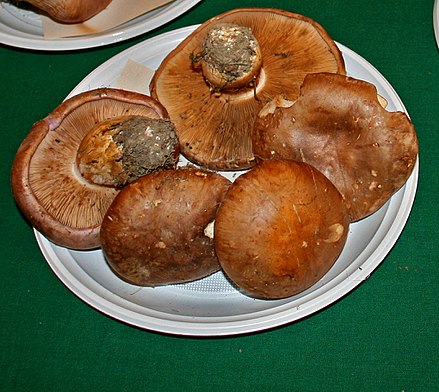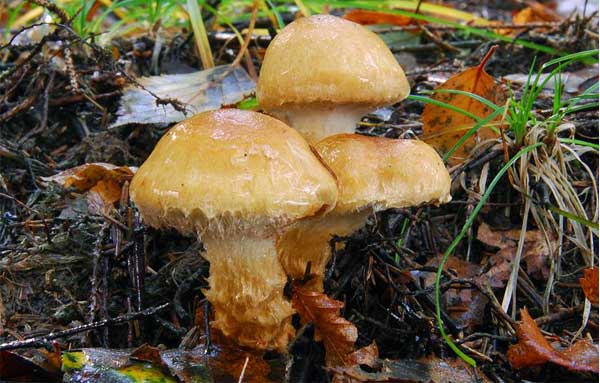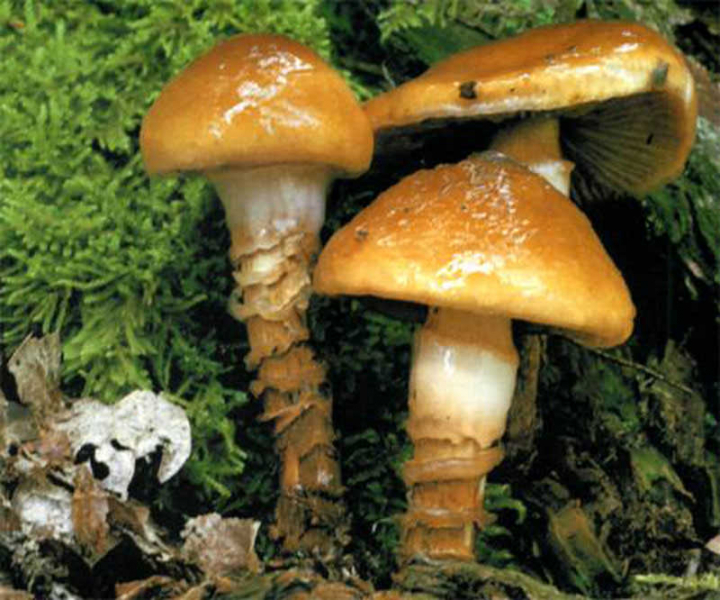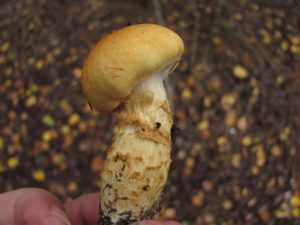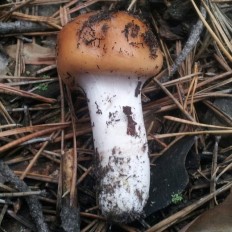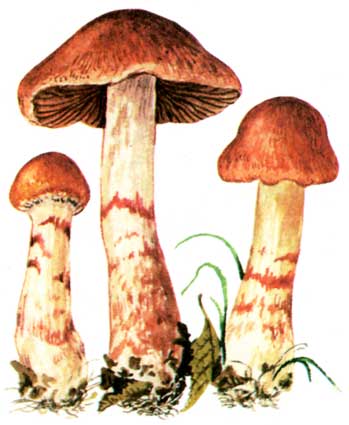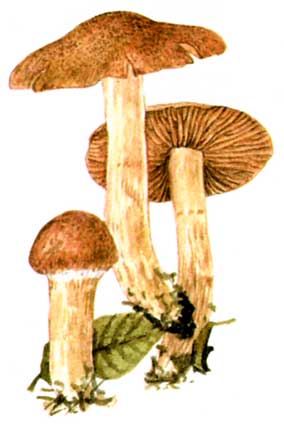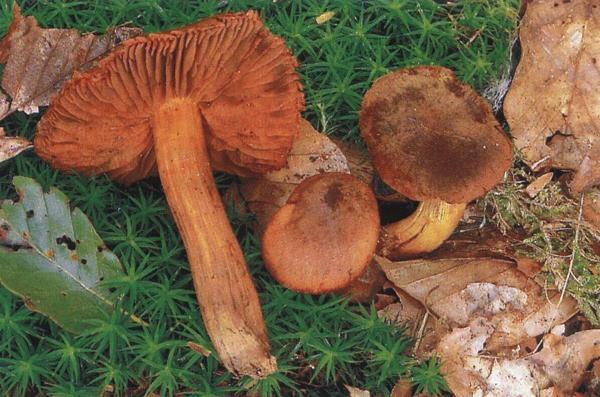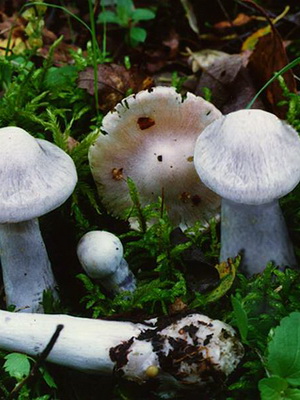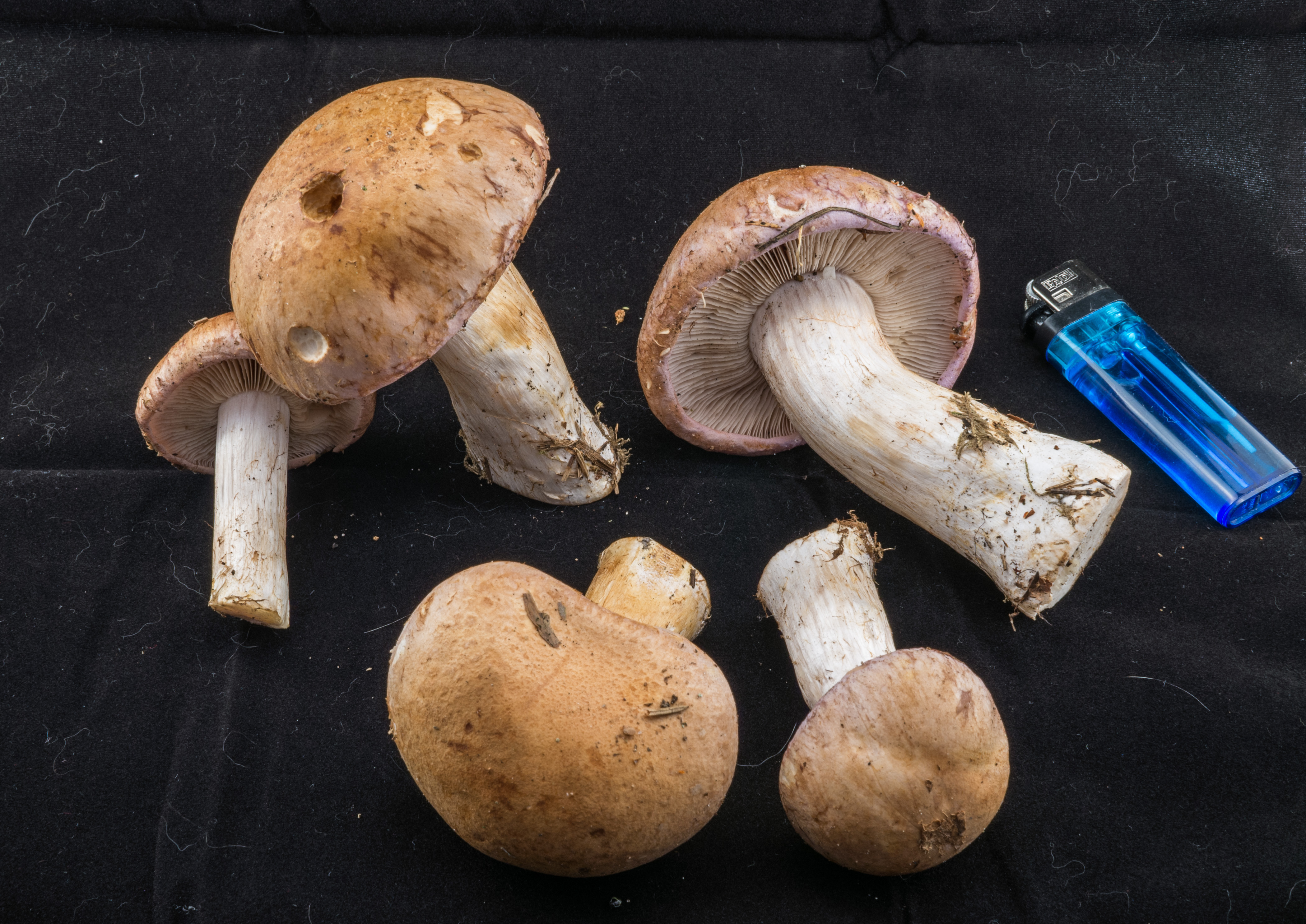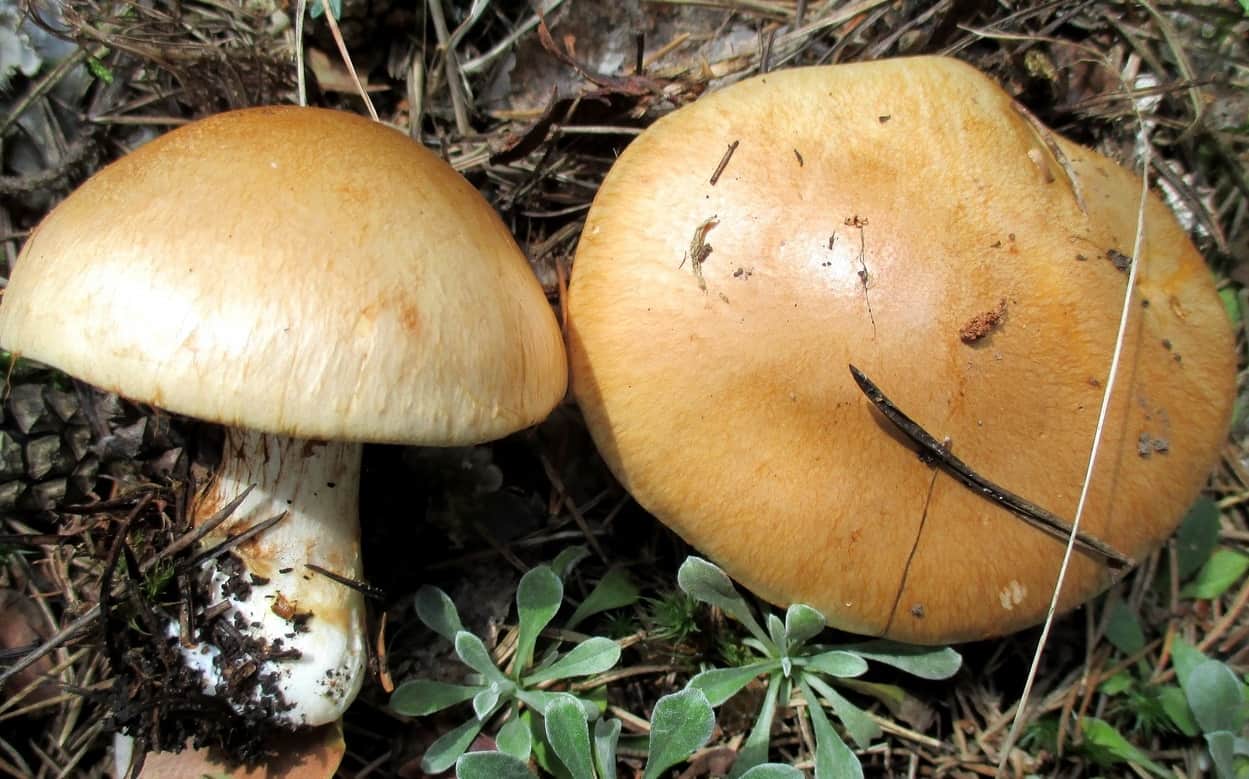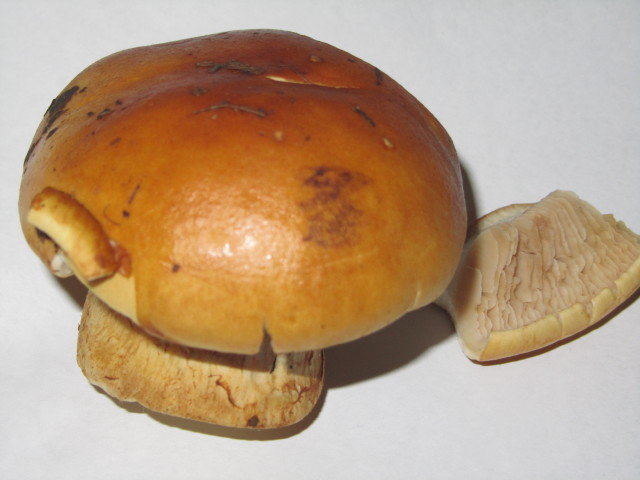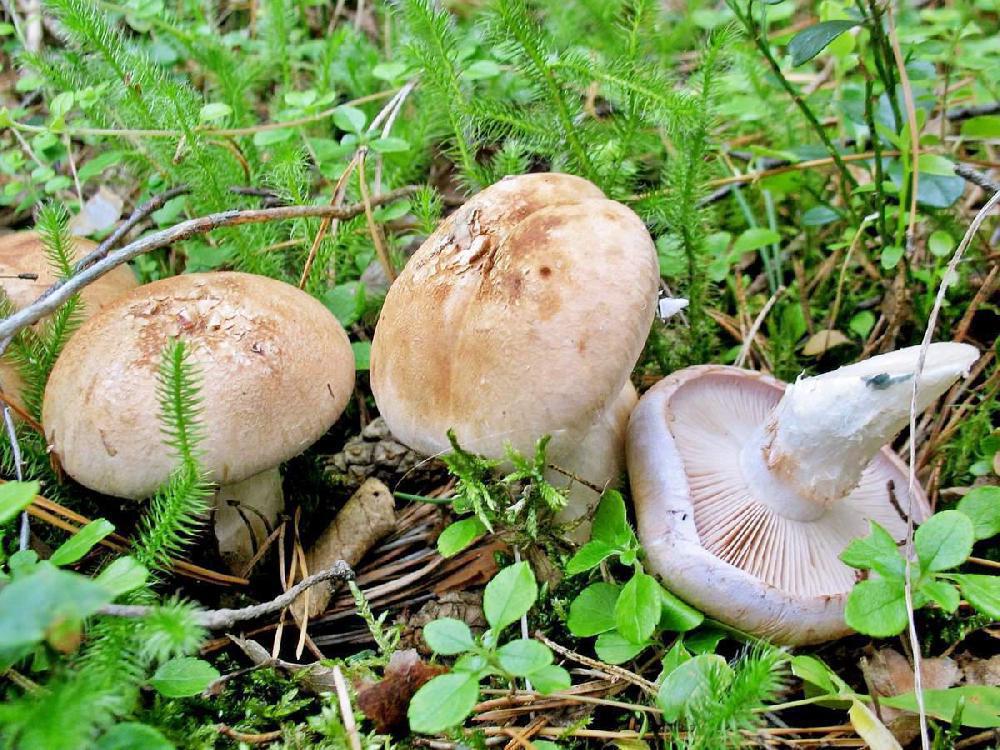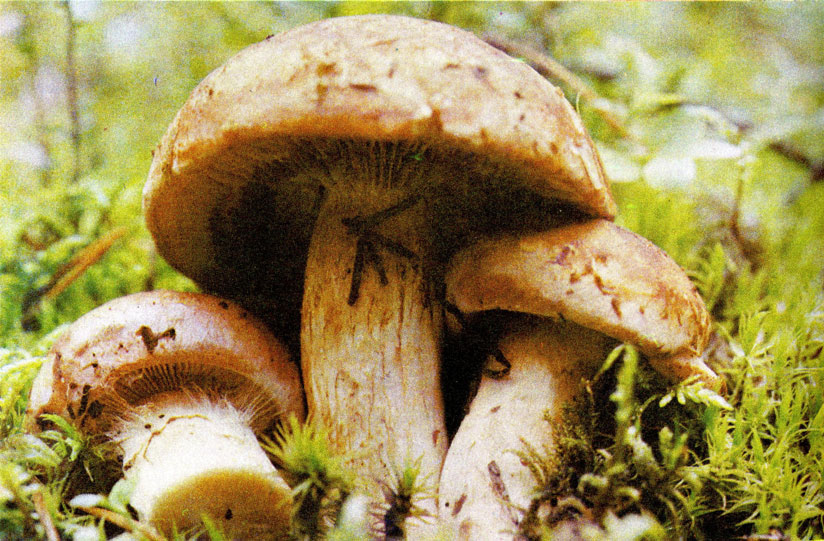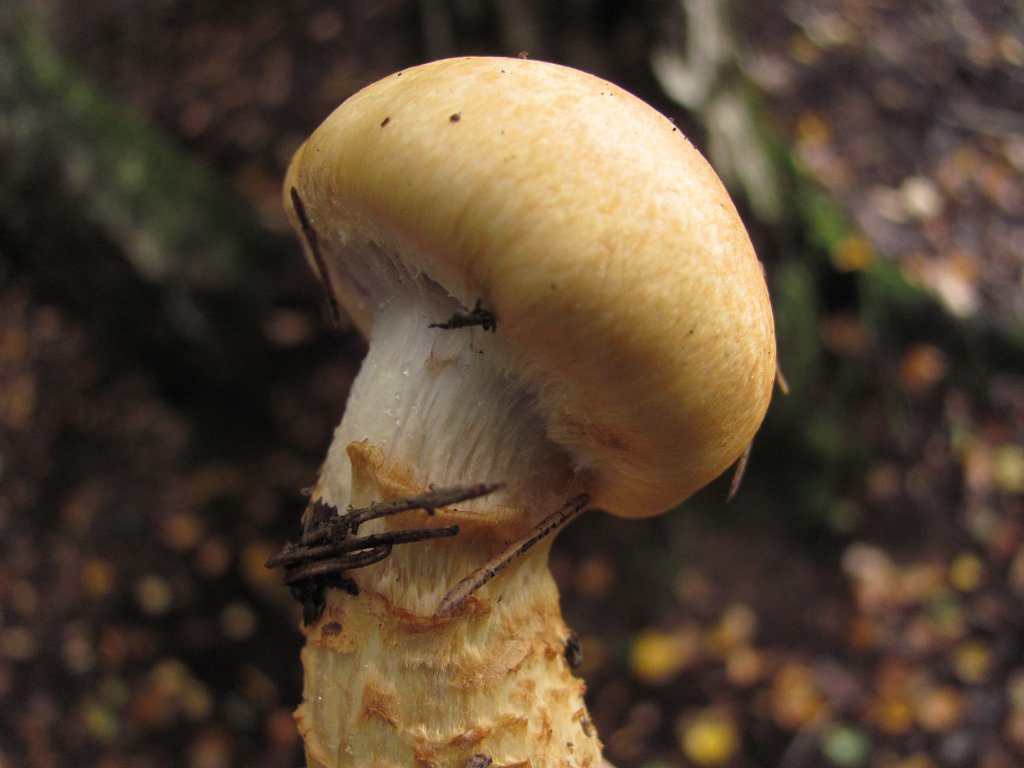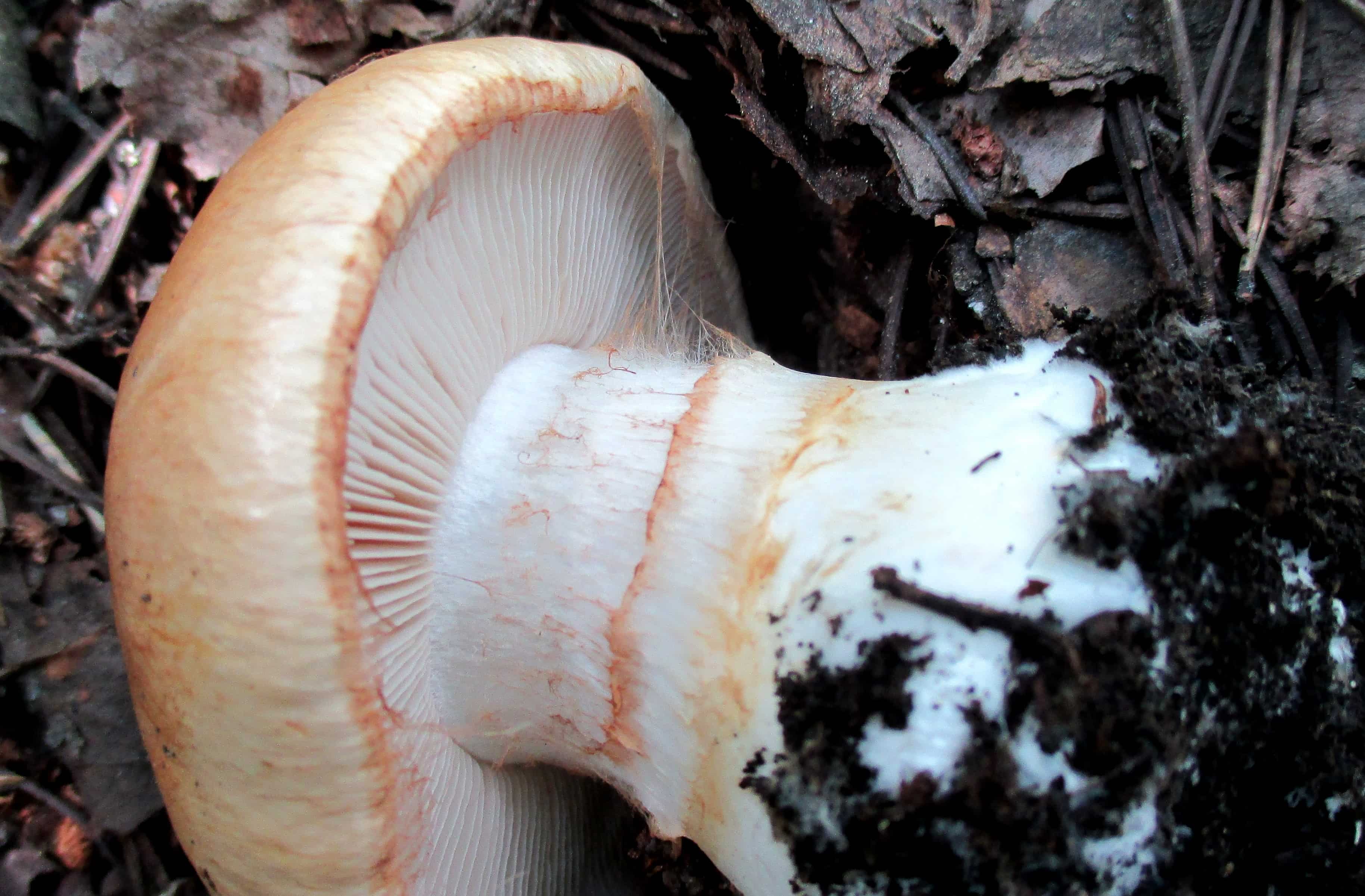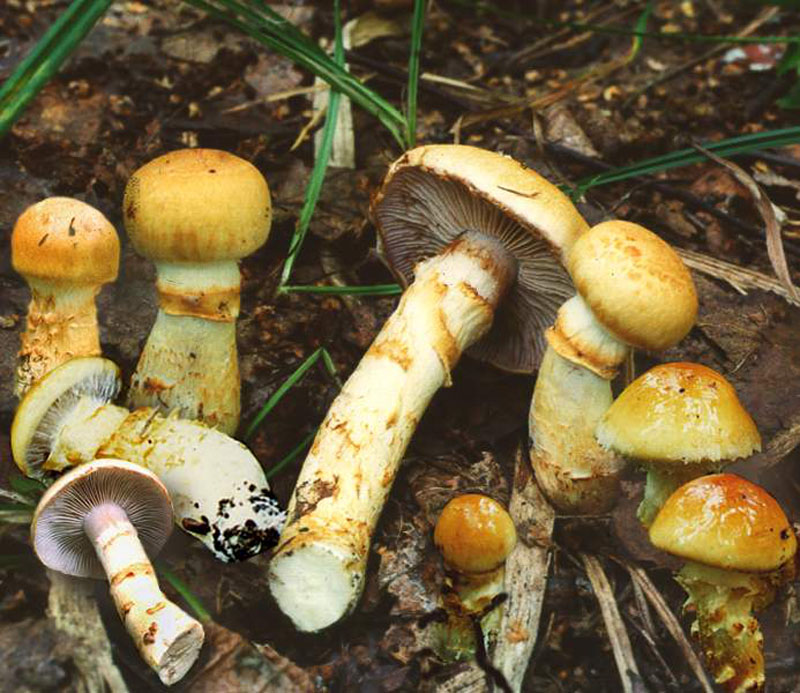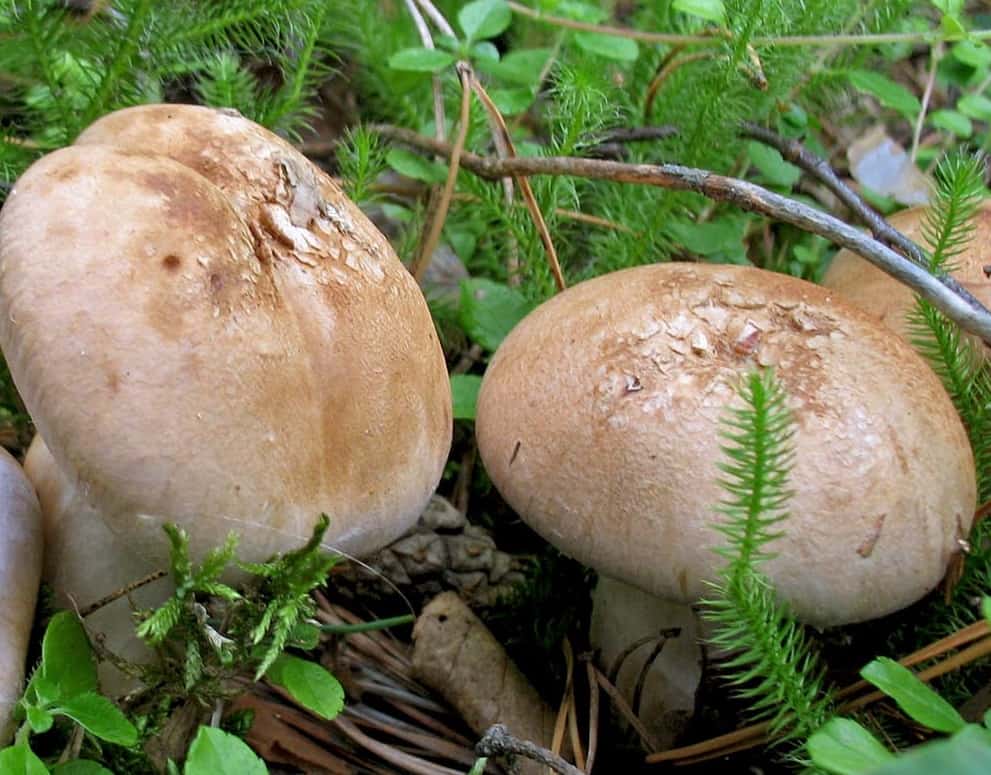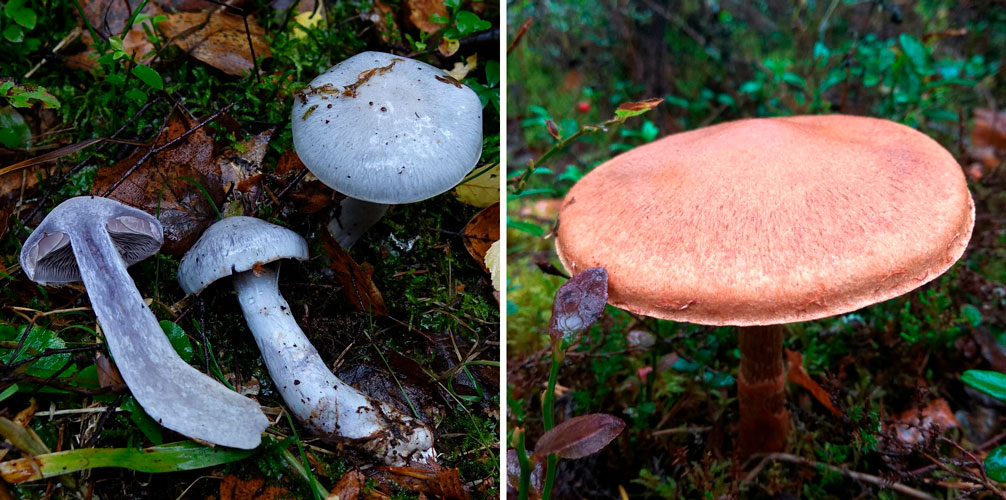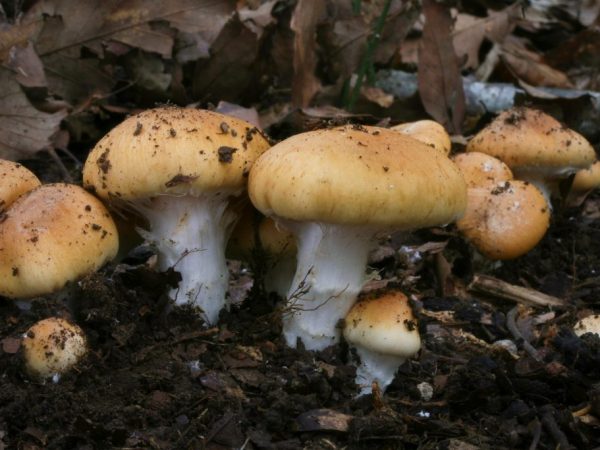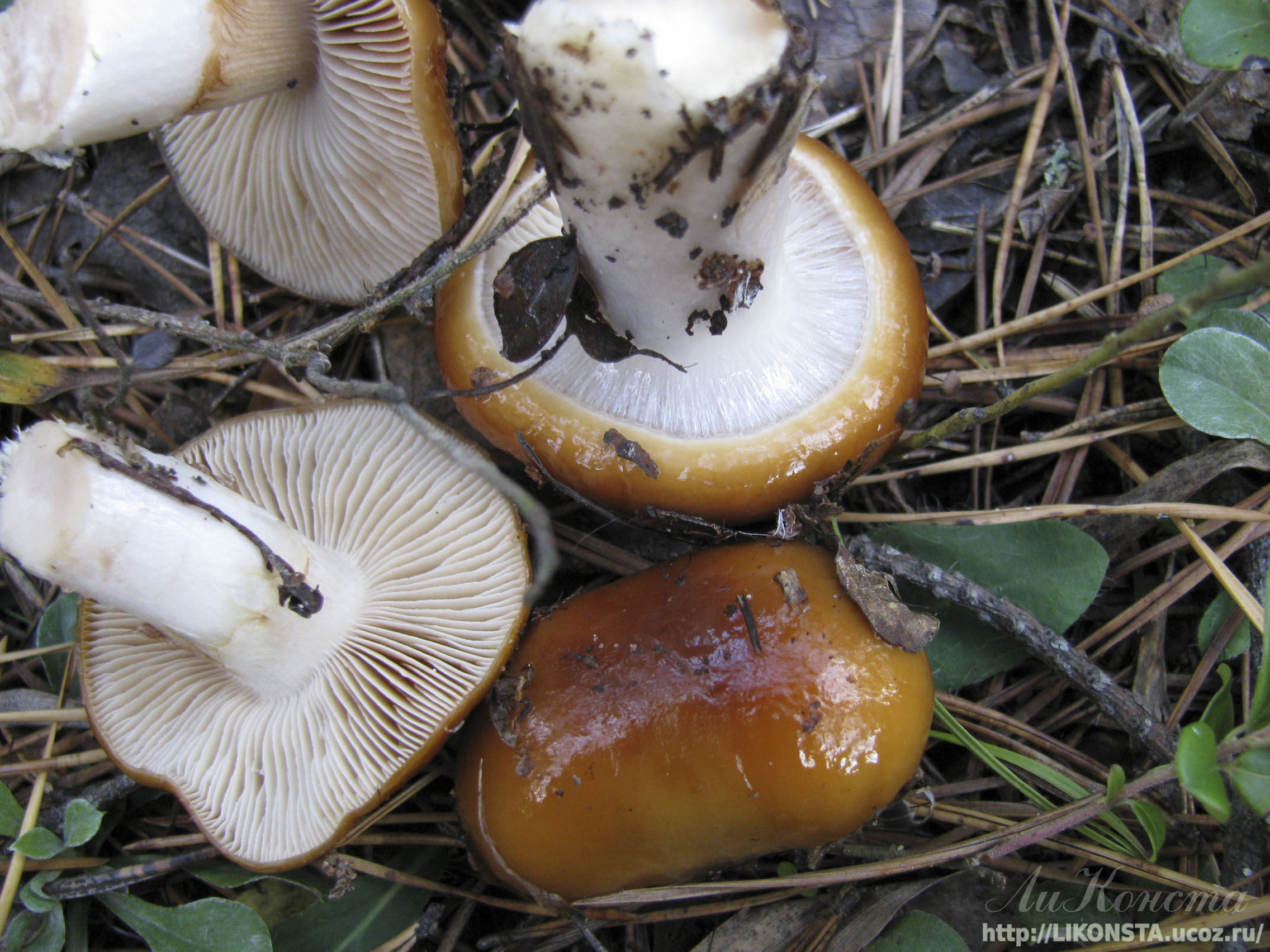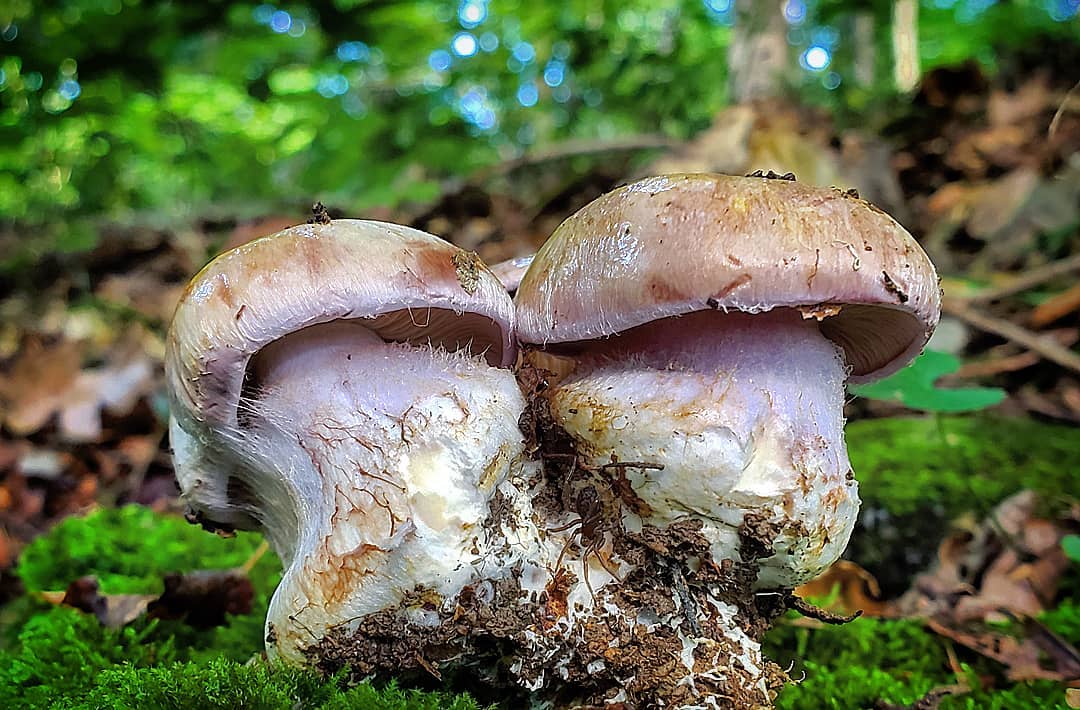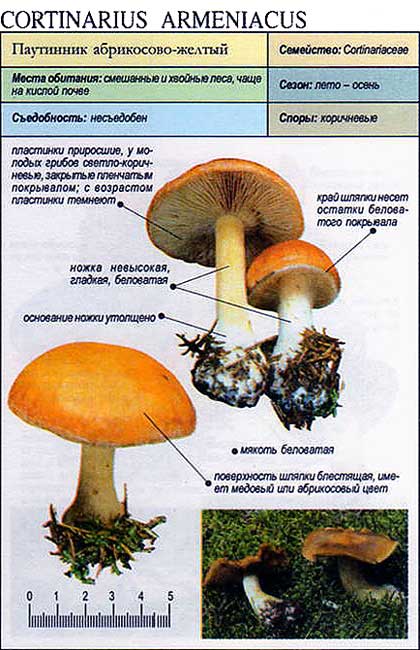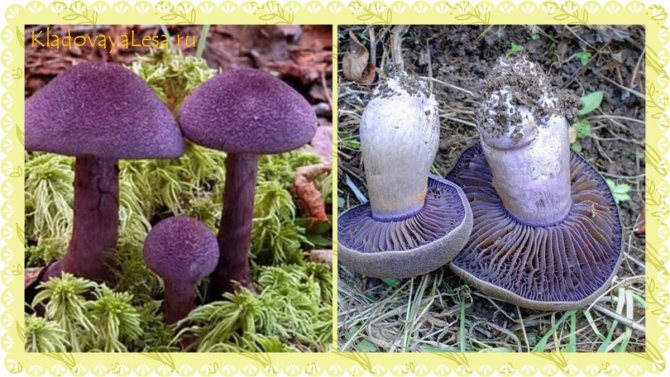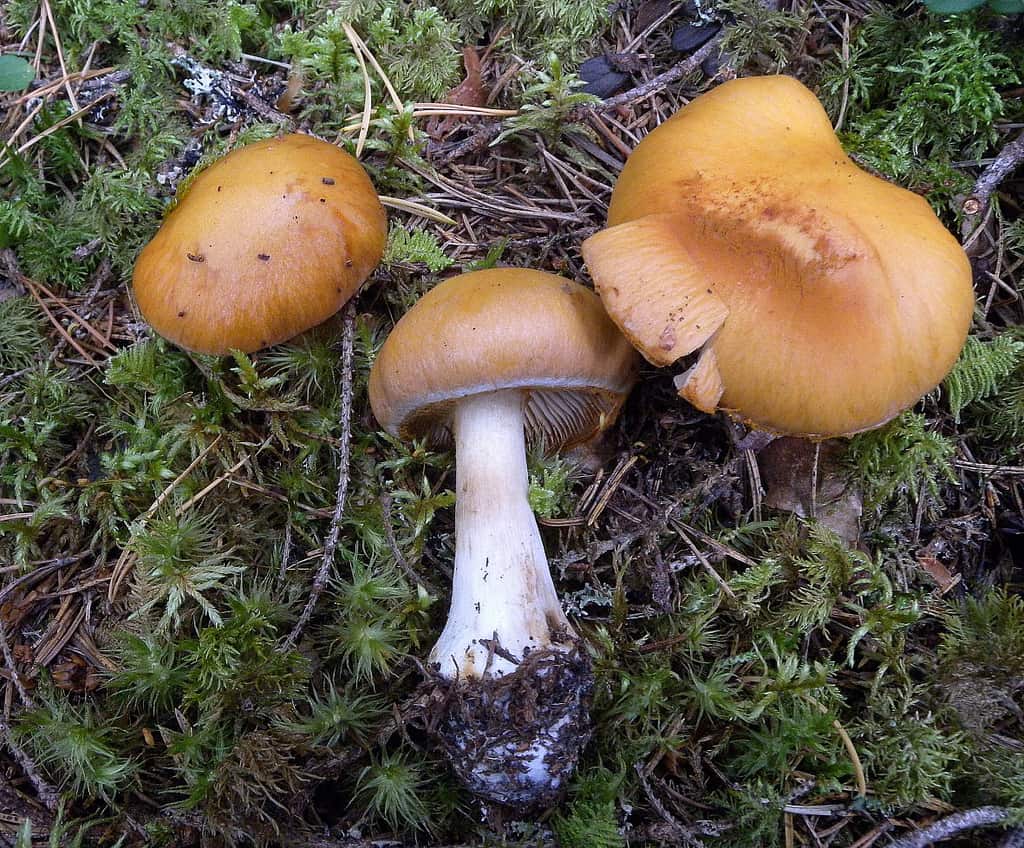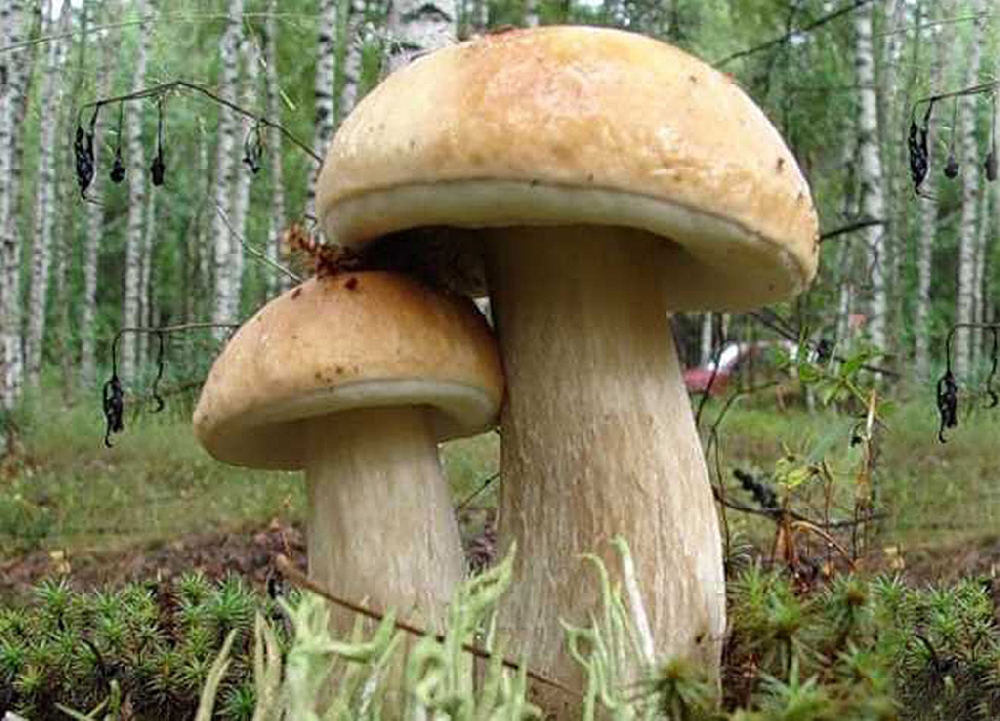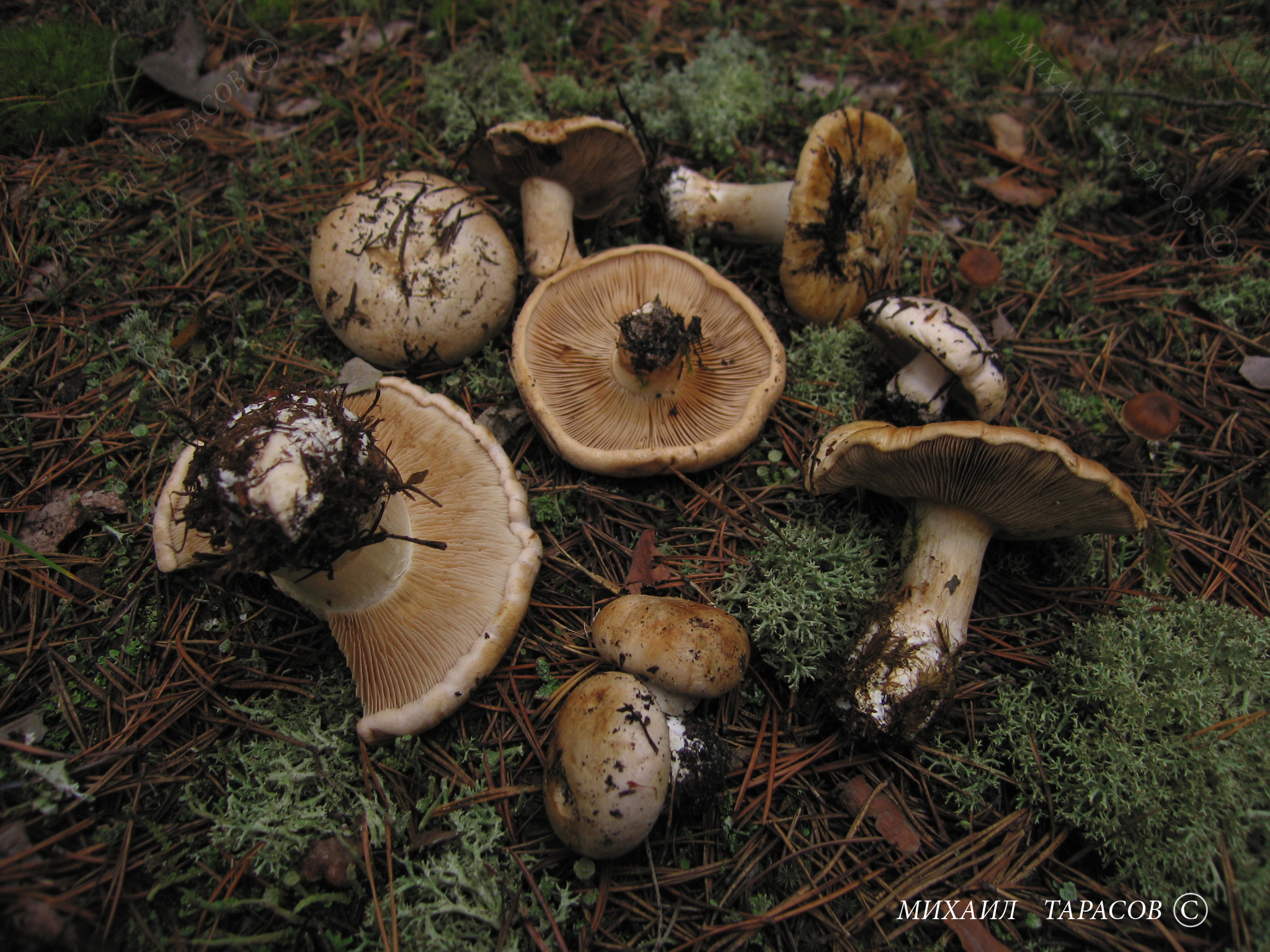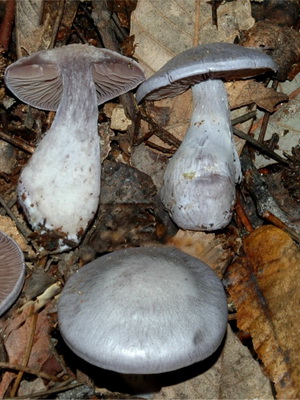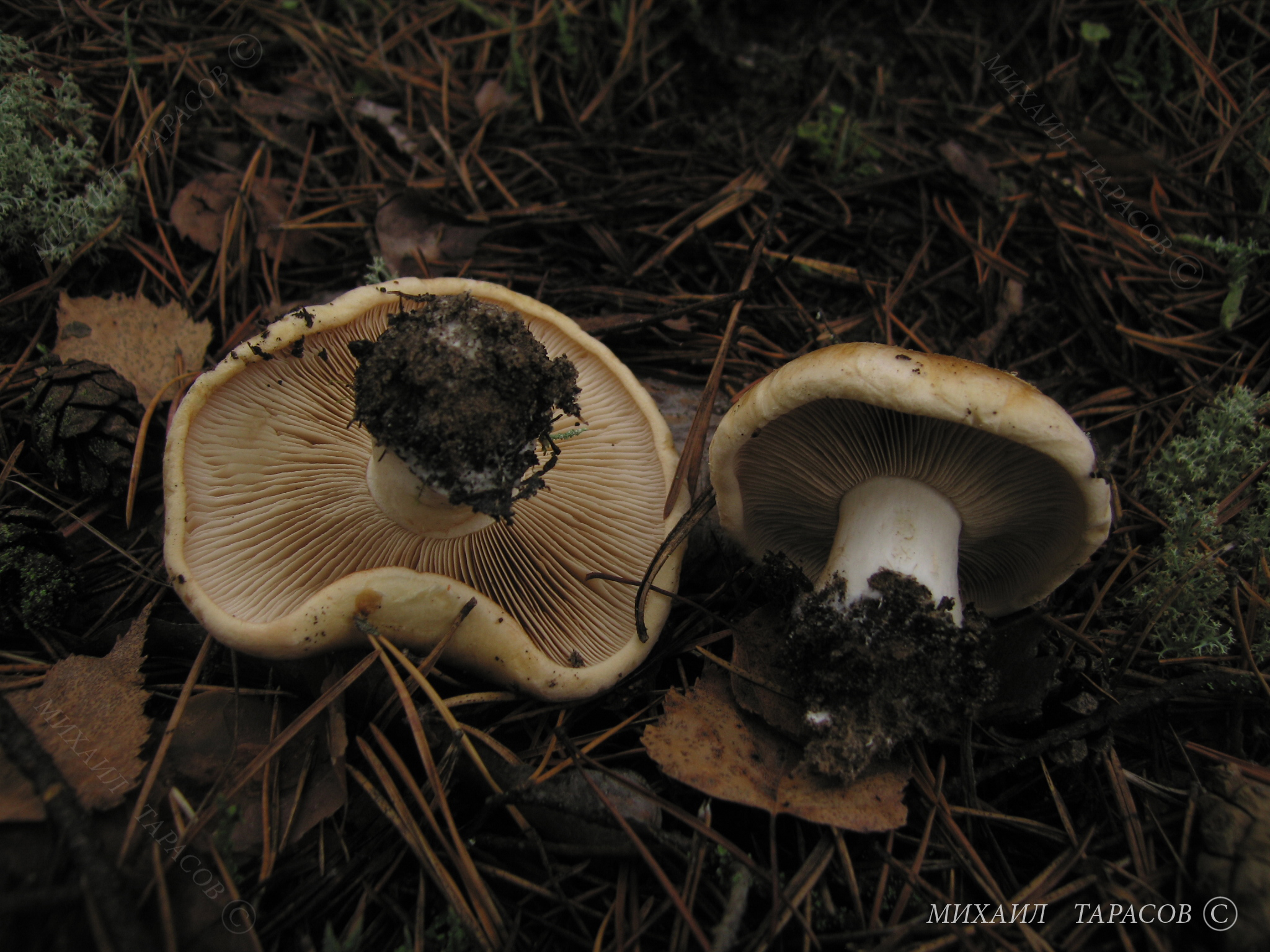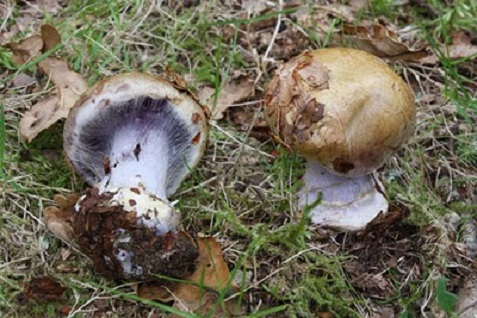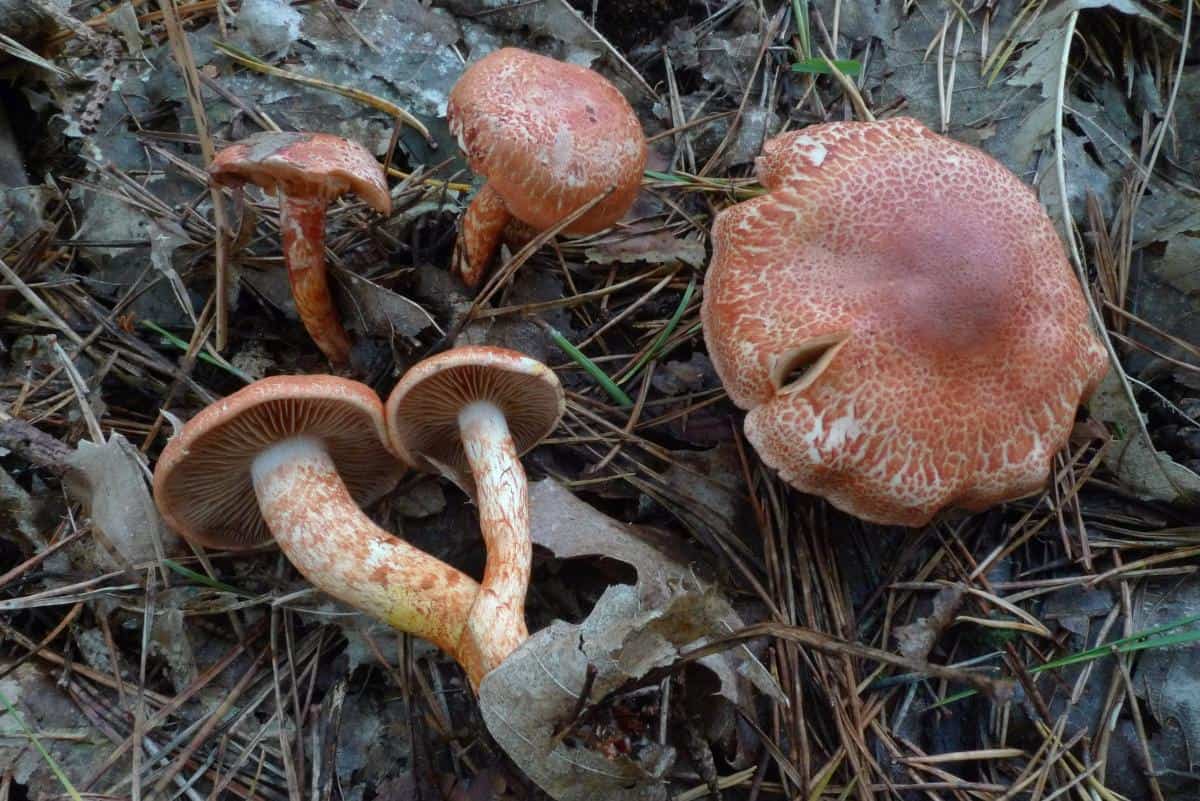Dangerous doubles
In many foreign sources, piggy is reasonably considered an inedible mushroom or refers to fruits with toxic components that have not yet been studied. In Russia, it is still classified as conditionally edible. It is not difficult to distinguish felt mushrooms, their individuality is quite pronounced.
| Name | Hat and leg | Hymenophore | Danger |
| The pig is fat | The hat is brown with a brown tint, the leg is much darker, very thick, often located on the side | Lamellar, honey, yellowish | Conditionally edible |
| The pig is thin | The hat is always olive-tinted, the leg is much lighter, located in the center | Lamellar, brown with a yellow or rusty tinge | Poisonous |
| Polish mushroom | The hat is chestnut, convex, the leg is light brown, with red-brown vertical stripes-fibers | Tubular | Edible |
| Flywheel green | The pillow-shaped cap is grayish or brown in color, located on a rather thin stem, which is covered with a brown mesh | Tubular | Edible |
The greatest danger lies in wait if you confuse the felt pig with a thin sister. You should very carefully pick mushrooms in the forest, in no case take dubious specimens into the basket.
Differences between a pig thin and thick
A detailed comparison of two related and very similar pigs is presented in the table. It is difficult to distinguish them even for experienced mushroom pickers.
| Name | Felt pig | Slim Pig |
| Hat | Brown or brown, velvety, often cracks when ripe, the center has a depression | Brown with olive, grayish or rusty tint. Dry, fluffy, sticky in the rain. Slightly convex at first, then flat |
| Leg | Thick, short, much darker than the cap, often shifted to the side, felt surface | Short, thin, matte, gray-yellow or olive, much lighter than the cap, less often the same color |
| Hymenophore | Yellowish, descending the leg, darkened by touch | Pseudo-lamellar, the layer extends from the bottom of the cap. The color is brown with a yellow or rusty tinge, darkens when pressed |
| Pulp | Bitter, no smell, yellow, watery | Soft, odorless and tasteless, usually wormy in dry weather |
| Danger | Edibility is not fully understood, but cases of poisoning have been recorded | The toxins contained in the mushroom after cooking do not disappear, many deaths have been recorded, cannot be eaten, it is poisonous |
Often, a slender pig causes allergies, accumulates a large amount of heavy metals and gradually unbalances all body functions. German mycologist Julius Schaeffer was the first to die from eating this mushroom in 1944.
The main difference is still in the leg
When harvesting, you should pay special attention to it.
Tapinella panuoides
- Other names for the mushroom:
- Ear-shaped pig
- Paxil panusoid
- Mine mushroom
- Pig underground
- Burial mushroom
Synonyms:
- Paxil panusoid;
- Mine mushroom;
- The pig is underground;
- Burial mushroom;
- Serpula panuoides;
Tapinella panuoides is a lamellar mushroom widespread in Kazakhstan and Russia.
External description
Panus-shaped tapinella is a fruiting body, consisting of a wide cap and a small, spreading out in the width of the leg. Most mushrooms of this type have almost no stem.
If the panus-shaped tapinella has a leg-shaped base, then it is characterized by high density, rubbery, dark brown or brownish in color, and velvety to the touch.
The tissues of the fungus are fleshy, have a thickness of 0.5-7 mm, a light brown or yellow-cream shade, when dried, the pulp becomes spongy.
The diameter of the mushroom cap varies from 2 to 12 cm, is fan-shaped, and sometimes shell-shaped. The edge of the cap is often wavy, uneven, and serrated. In young fruiting bodies, the surface of the cap is velvety to the touch, but in mature mushrooms it becomes smooth. The cap color of the panus-shaped tapinella varies from yellow-brown to light ocher.
The fungal hymenophore is represented by a lamellar type, while the plates at the fruiting body are narrow, located very close to each other, blown out near the base. The color of the plates is cream, orange-brown or yellow-brown. If you press on the plates with your fingers, it will not change its shade.
In young fruit bodies, the pulp is characterized by great rigidity, however, as it ripens, it becomes more lethargic, has a thickness of no more than 1 cm.On the cut, the pulp of the mushroom often becomes darker, and in the absence of mechanical action it has a dirty yellow or whitish color. The mushroom pulp has no taste, but it has a coniferous or resinous aroma.
The spores of the fungus are 4-6 * 3-4 microns in size, smooth to the touch, wide and oval in appearance, brown-ocher in color. The spore powder has a yellow-brown or yellow color.
Season and habitat of the mushroom
Tapinella panuoides belongs to the category of saprobic mushrooms that bear fruit from mid-summer to the very end of autumn. Fruit bodies are found both singly and in groups. This type of mushroom prefers to grow on coniferous litter or dead wood of coniferous trees. The fungus is widespread, often settles on the surface of old wooden buildings, provoking their decay.
Edibility
Panus tapinella is a slightly poisonous fungus. The presence of toxins in it is due to the presence of special substances in the composition of the fruit bodies - lectins. It is these substances that cause the clumping of red blood cells (red blood cells, the main components of blood).
Similar types and differences from them
The appearance of the panus-shaped tapinella does not stand out too much against the background of other fungi of this genus. Often this mushroom is confused with other varieties of lamellar mushrooms. Among the most famous varieties similar to the panus-shaped tapinella are Crepidotus mollis, Phyllotopsis nidulans, Lentinellus ursinus. For example, Phyllotopsis nidulans, in comparison with tapinella panusoid, prefers to grow on deciduous wood, has a rich orange cap. At the same time, the cap of this mushroom has even (and not serrated and wavy, as in the panus-shaped tapinella) edges. The mushroom Phyllotopsis nidulans does not have a very pleasant pulp aroma. The Crepidotus mollis fungus grows in groups, mainly on deciduous trees. Its distinctive features are less wrinkled plates, a cap of a light ocher hue (in comparison with tapinella panusoid, it is not so bright). The color of the fungus Lentinellus ursinus is pale brown, its cap is the same in shape as that of the panus-shaped tapinella, but its hymenophore is distinguished by narrow plates, located often. This type of mushroom has an unpleasant odor.
Other information about the mushroom
The etymology of the name of the fungus tapinella panus is interesting. The name Tapinella comes from the word ταπις, which means carpet. The epithet "panus-shaped" characterizes this type of mushroom as similar to Panus (one of the genera of mushrooms).
Description of the types of pigs
Most varieties of pigs are conditionally poisonous. Since 1981, they have been excluded from the all-Union list of products suitable for cooking. Despite such prohibitions, some species are salted and prized for their taste and cold canning method. The most common are thin-legged, alder and fat pigs, other names are cowshed, dunka, pig. We will consider them in this article.
What mushrooms look like and where
Pigs can be found in deciduous or coniferous forests, at the edge of the forest near the glades.Often the cowshed grows on upturned tree roots, old anthills, in clearings. Grows in moist soil, occurs in summer and autumn.
The slender pig and the aspen pig differ in the places of growth, in the appearance and color of the cap.
Alder pig's cap: 8-20 cm in diameter, initially convex. The color is brown or brown with an olive tint.
External features and their properties
The pig cannot be confused with other species because of its distinctive features: a beautiful velvety cap, plates, color. The surface is velvety, as it ripens, it becomes dry, cracks, takes on a disproportionate shape. The plates are descending, frequent, branching in shape. They are yellowish in color, which turns dark when pressed.
Gallery: types of cobwebs (45 photos)
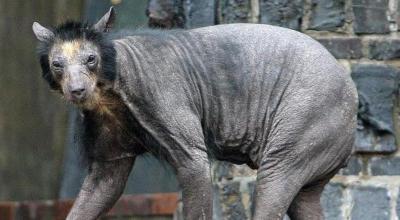





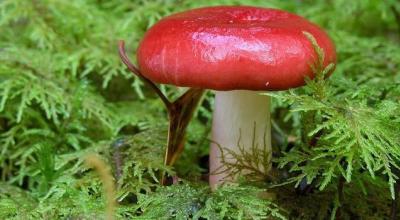
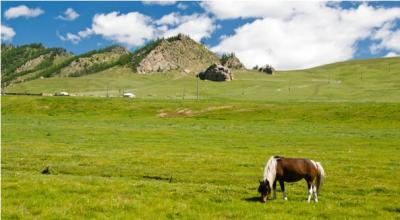

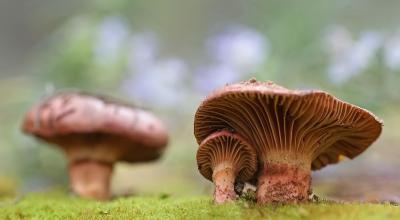


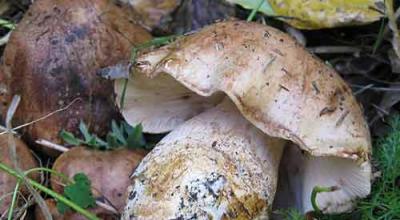


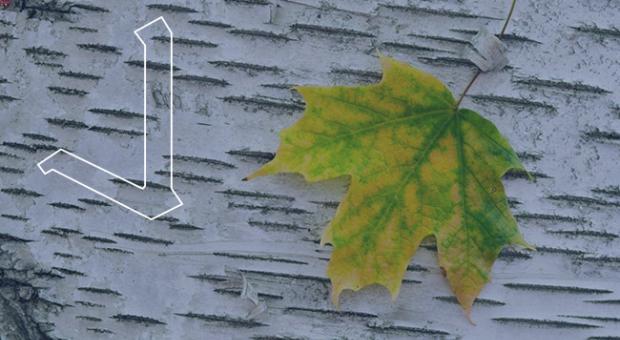
Cortin.triumрhans - has a hemispherical or cushion-shaped, half-open upper part of an orange-yellow coloration with the remnants of a bedspread and a sticky or dry surface covering a thick, soft, whitish-yellowish pulp with a pleasant aroma. The plates are weakly adherent, narrow and frequent, light smoky-cream or bluish-brown in color with a rusty-reddish-brown spore powder. The lower part of the fruiting body is strongly thickened, cylindrical in shape.
Cortin.albоviolaceus - has a rounded bell-shaped, convex or convex-outstretched cap with an elevation in the central part and a silky fibrous, shiny, smooth, sticky surface of lilac-violet-silver or white-lilac coloration. Plates are medium-frequent, narrow, grayish-blue, gray-ocher or brownish-brown, with the presence of rusty-reddish-brown spore powder. The area of the leg is clavate, with weak mucous membrane. The soft part is thick and watery in places
, gray-blue, brownish, with an unpleasant odor.

Cortin.armillatus - has a hemispherical, gradually opening, cushion-shaped cap with a wide and obtuse tubercle in the central part, covered with dry and fleecy, orange or reddish-brown coloration with remnants of a red-orange-brown blanket. The soft part is thick and dense, brownish in color, with a pronounced musty odor in the absence of mushroom taste. Plates of an adherent type, wide and relatively sparsely located, grayish-cream, slightly brownish or rusty-brown in color, with brown-rusty-red spore powder. The lower part of the fruiting body is lighter
, with an extension at the base, with bracelet-like remains of the bedspread.
The webcap is special
Cortin.rubellus - has a conical or prostrate-conical cap, with a sharp tubercle in the center and a fine-scaly, reddish-orange, reddish-orange or bright brownish surface, covering the tasteless and radish-smelling flesh of a reddish-orange-orangish tinge. Thick and wide plates are rare, growing to the stem,
orange-ocher or rusty-brownish color, with rusty-reddish-brown, spherical spores with roughness. The lower part of the fruiting body is cylindrical, of sufficient density.
Webcap purple (video)
Cortin.pholideus - has a bell-shaped, slightly convex, with a blunt elevation in the center and numerous scales of a dark brown coloration of the cap, covered with a pale brown, brownish-brown skin. It is distinguished by rare, grayish-brownish plates with a lilac-violet tint and the presence of a brown spore powder. The lower part of the fruiting body is cylindrical or weakly clavate, with an extension at the base, solid or hollow, with a smooth, grayish-brownish scaly surface. Loose type, gray-violet-brownish the pulp has a faint musty odor.
Kira Stoletova
One of the most common types of mushrooms in the temperate zone is the spiderweb mushroom. It belongs to the group of conditionally edible mushrooms. The genus Spiderweb from the family of the same name Spiderweb is dangerous because there are poisonous species.

Tapinella panuoides (lat.Tapinella panuoides)
Name Tapinella panusoid.Latin name: Tapinella panuoides.Other names: Ear-shaped pig, Paxil panus-shaped, Mine mushroom.Department: Basidiomycota.Class: Agaricomycetes.Order: Boletovye.Family: Tapinella.Genus: Tapinella.Poisonous mushroom.
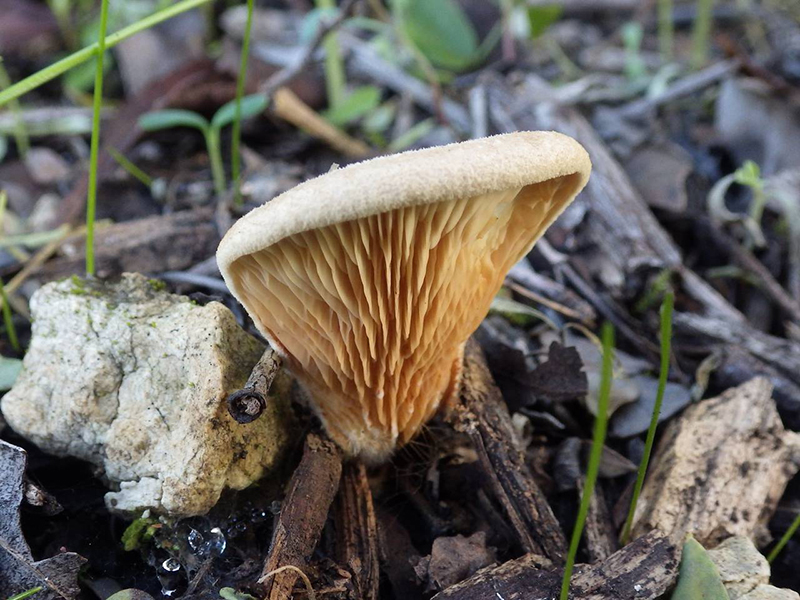 Name Tapinella is panus-shaped.Latin name: Tapinella panuoides.Other names: Ear-shaped pig, Paxil panus-shaped, Mine mushroom.Department: Basidiomycota.Class: Agaricomycetes.Order: Boletovye.Family: Tapinella.Genus: Tapinella.Poisonous mushroom.
Name Tapinella is panus-shaped.Latin name: Tapinella panuoides.Other names: Ear-shaped pig, Paxil panus-shaped, Mine mushroom.Department: Basidiomycota.Class: Agaricomycetes.Order: Boletovye.Family: Tapinella.Genus: Tapinella.Poisonous mushroom.
Scientific synonyms
Agaricus panuoides
Agaricus atrotomentosus
Paxillus panuoides
Rhymovis panuoides
Crepidotus panuoides
Plicaturella panuoides
Serpula panuoides
Very short, or not at all, does not differ in color from the cap.
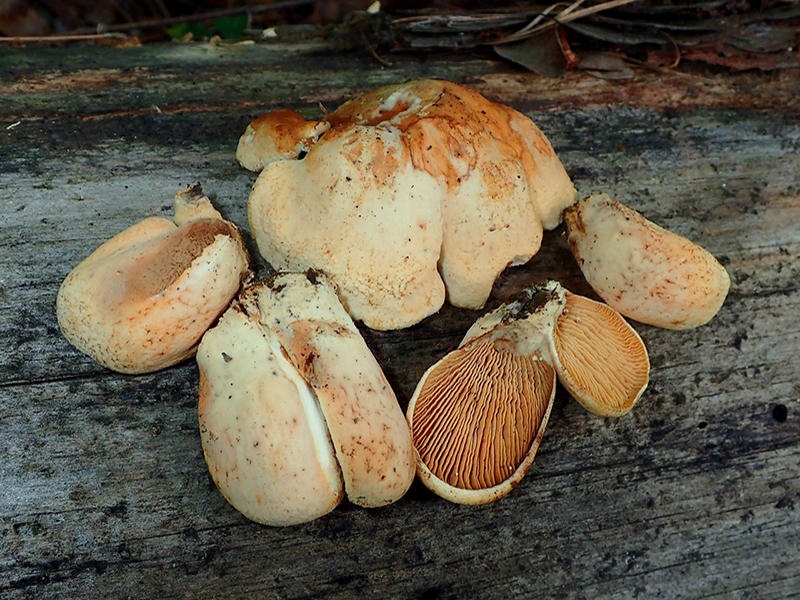
Hat
30–80 mm in diameter, has lateral attachment to the substrate (sessile), less often with a rudimentary stem, prostrate or domed in the form of a tongue or fan, at first the edge is tucked up, then often uneven, wavy. The skin is dry, in young fruiting bodies, slightly velvety, yellow-cream in color. As it grows, it becomes naked, the color changes to yellow-ocher, ocher-brown, yellow-brown or orange-brown. Mushroom caps often grow together.
Hymenophore
Lamellar, plates are frequent, radially diverging from one center, narrow, anastomosed at the base, whitish, yellowish-brownish, brown.
Whitish or dirty yellowish, not expressive odor.
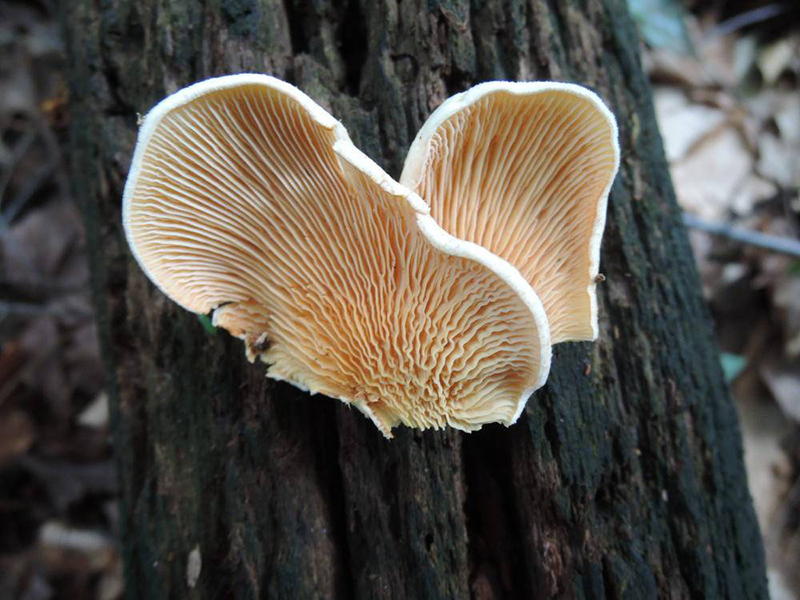
Habitat
They grow in forests, on stumps, fallen trees of conifers, singly or in groups, this mushroom also loves to grow in cellars and basements.
Similarity
Tapinella panuoides is similar to a fungus such as Pseudomerulius curtisii, which differs in a merulius hymenophore that has a different color.
|
December |
January |
February |
|
March |
April |
May |
|
June |
July |
August |
|
September |
October |
November |
The nutritional value
It is considered a poisonous mushroom, this is due primarily to the fact that the mushroom contains lectins that cause clumping of red blood cells.
Treatment for poisoning
An ambulance is required to be called as soon as the first symptoms of poisoning appear. Before the arrival of the doctors, the patient is given plenty of fluids to drink. Strong herbal tea without sugar or purified water at room temperature has a good effect. This allows you to empty the stomach and remove more toxic substances.
To stimulate the release of toxic substances from the body, the following means are used:
- Smecta;
- Enterosorbent;
- Enterosgel;
- Activated carbon.
In case of severe poisoning, a laxative or enema helps. This significantly increases the release of harmful substances from the stomach.
Strong herbal tea without sugar helps with poisoning
Contraindications for first aid:
- take funds that improve the work of the gastrointestinal tract (indigestion will delay the ingress of poison into the blood);
- give enemas to people of age;
- induce a gag reflex in children under 3 years of age and in pregnant women.
Doctors are hospitalizing a patient who has been poisoned by mushrooms. He is prescribed drug detoxification. The type of procedure depends on the volume of toxic substances in the body, as well as the physiological characteristics of the patient.
Detoxification methods:
- gastric lavage;
- hemodialysis;
- enema.
Recovery from poisoning
After detoxification, the patient restores the water and electrolyte balance in the body. For this, antibiotics are used in the form of tablets, injections. In acute cases of mushroom poisoning, droppers are placed. For recovery, the patient is prescribed a special diet.
Nutritional rules after poisoning by Piggy Tolstoy:
- you can not eat fried, smoked, fatty and spicy foods;
- refusal from alcohol and cigarettes;
- you should eat boiled or steamed food;
- you can only eat chopped fruits and vegetables.
Cobweb smooth-skinned
Habitats of the smooth-skinned penny (Cortinarius allutus): coniferous and deciduous forests, in damp places, near swamps, grow in groups.
Harvesting season: July - October.
The hat has a diameter of 4-8 cm, sometimes up to 10 cm, at first hemispherical, later convex-outstretched. A distinctive feature of the species is a yellow-orange cap with lighter, often wavy edges. With age, the edges of the cap crack.
Look at the photo - this edible spider web has a high leg, 4-10 cm and 6-18 mm thick, widened at the base, light brown, often with a purple tint:
The flesh is whitish or bluish, at the break it changes color to brownish and even purple, without much taste or smell.
The plates are adherent, at first creamy with a purple tint, later rusty-brown. Variability. The cap color ranges from light brown to yellow-orange with lighter edges.
Similar species. The smooth-skinned webcap is similar in shape to the brown webcap (Cortinarius brunneus), which is distinguished by the dark brown color of the cap.
The smooth-skinned spiderweb mushroom is edible, belongs to the 4th category.
Cooking methods: frying, after preliminary boiling for at least 25 minutes.
Webcap purple

The purple webcap (Latin name - Cortinarius Violaceus) is an edible mushroom of extraordinary beauty. Quite often it can be found in deciduous and coniferous forests. This plant is listed in the Red Book of the Russian Federation, as it is a very rare species of mushrooms.
The webcap belongs to the Lepista genus, to the Buttercup family. The following characteristic will present all the features of this plant.
Edible: conditionally edible.
Description
The purple spider web, or sometimes it is called the purple spiderweb, is the adornment of any forest. Despite the fact that it is conditionally edible, it is not recommended to collect it due to its uniqueness. During the mushroom season, it can be found only once. Its number decreases every year.
The mushroom cap can be up to 15 cm in diameter. It can be hemispherical or flat. There is a tubercle in the center. A young mushroom has a purple cap. In rare cases, its color may be red. It can fade over time. In the lower part there are wide plates.
The pulp at the break has a blue tint, and the smell of the mushroom is almost not felt. The pulp is quite fragile, it is easy to break it in your hands.
The stem of the mushroom is long and pleasant to the touch. The same can be said about armor. A thickening can be seen towards the base. During maturation, the stem can become tubular. The outer layer of the fungus is purple in color.
Where do they grow?
Very often, a purple cobweb can be found in damp birch forests. It can appear under spruce and pine trees. The most popular are single specimens, but groups of cobwebs are also rare.
Types of cobwebs
There are many varieties of cobwebs. The following are the most common ones:

• White and purple spider web. This mushroom cap belongs to the lamellar group. Its cap can reach 12 cm in diameter, and its edges are connected to the stem with a cobweb blanket. The flesh of the mushroom can be brown or light brown. It tastes and smells good.

• Scaly webcap. Its cap can be about 10 cm in diameter, it is convex or flat. In wet weather, it is slimy and shiny.

• The webcap is yellow. The most common representative of cobwebs, sometimes it is called yellow or triumphant spiderweb.
Beneficial features
The webcap contains many vitamins. It is composed of B1 and B2, zinc, copper, manganese. This mushroom is characterized by stearic acid and ergosterol. The medicinal properties of this plant are noted by many pharmacists. Such a conditionally edible mushroom is used in the manufacture of remedies for fungus, antibiotics. It is able to lower glucose levels. It can also be used to create drugs that control hypoglycemia.The cobweb has anti-inflammatory properties, it perfectly supports the activity of the immune system. Due to the large amount of vitamins, it helps to normalize the digestive tract, it also protects the body from infections and prevents overwork, fatigue.
Contraindications
If you take into account how much benefit this mushroom has in itself, you can understand that the contraindications here are insignificant. Some edible mushrooms can be confused with inedible mushrooms. The threat is posed by cobwebs that were collected near the road. They managed to absorb all the toxic substances. Such mushrooms are contraindicated for people with gastrointestinal diseases.
How to make a purple spider web salting?
To salt such a mushroom, it must be thoroughly washed and cleaned of contaminated areas. Then they are boiled in salted water. The water needs to be drained and then you can proceed to pickling the mushrooms.
You need to marinate them with vinegar, sunflower oil, salt and pepper. The mushrooms need to be immersed in a saucepan, add the listed ingredients and put on low heat. Spiderweb mushrooms will secrete a liquid in which salting occurs. Then they can be laid out in banks and stored for no more than 12 months in a cool place.
Interesting Facts
Poisonous species of spider webs show their dangerous qualities for humans only after a week, and often after 14 days. In this regard, people do not always associate health problems and previously eaten fruits.
Spiderwebs are the largest fungal genus and at the same time the least researched. In addition, the genus Cortinarius is divided into subgenera, which contain specimens similar to each other.
If you come across edible cobwebs in the forest, you should definitely try to cook them. They will make a special impression even on the sophisticated lover of forest gifts. The main thing is to be attentive to the collection and not to take unknown and dubious specimens into the common basket.
Cooking recipes
The unsurpassed taste of the bbw is appreciated by many lovers of quiet hunting, who were lucky enough to find this mushroom in the forest. It is good in any form, but especially in pickled and fried. If you meet a fat woman in the forest, then you definitely need to cook and taste it.
Primary processing
Even if the mushroom is fairly clean, it is worth inspecting it for rot and worminess. Before proceeding with further cooking, the fatties should be washed.
Cooking
To boil a fatty mushroom, you need water and salt. For 1 kg of fruit you will need:
- Add 1 tbsp to 2 liters of water. l. salt.
- Boil.
- Then immerse the mushrooms, washed and cleared of forest debris.
- Boil for 10-15 minutes.
Then you need to drain the water and leave the fruits to cool.
How to cook pickled cobwebs for the winter
In order to have on hand a delicious delicacy from forest gifts in winter, you will need:
- edible cobwebs - 2 kg;
- salt - 2 tbsp. l .;
- sugar - 1 tbsp. l .;
- vinegar - 2 tbsp. l .;
- cloves, laurel, allspice peas - 4 pcs.;
- horseradish leaves, currants and cherries - 4 each.
Then you need to marinate the mushrooms, which are pre-peeled and boiled:
- Spices are mixed with salt and sugar in a container with water.
- Bringing the marinade to a boil, add vinegar and after 30 seconds the fat one.
- Cook for another 15 minutes, in parallel, horseradish, currant and cherry leaves are laid out in 4 half-liter jars.
- Fruits are laid out in a prepared container and poured with marinade so that it covers their surface.
- Then the containers are sterilized for 30 minutes and covered with lids.
Store mushrooms in a cool, dark place.
Freezing
To freeze the fatty mushrooms after boiling, it is enough to cool them, then put them in prepared containers and send them to the freezer. You can get them in portions as needed.
Frying
By itself, the edible spider web has a very pleasant aroma and sweetish taste, and therefore there is no need for its long preparation.You can fry fresh mushrooms, pre-boiled or frozen. Depending on this, the cooking procedure differs, the composition of the ingredients will be the same:
- mushrooms - 1 kg;
- onions - 200 g;
- salt, pepper to taste;
- vegetable oil - 20 ml.
Preparation:
- Fresh mushrooms are cleaned of forest debris, washed, and, if necessary, cut into pieces.
- First, finely chopped onions are fried in a small amount of fat or oil.
- After the onion has reached transparency, prepared mushrooms are added to it.
- The mass is fried until golden brown, after which it should be salted and pepper.
If the mushrooms are pre-boiled, then the roasting procedure will take less time, since the fatties are already ready and there is no need to simmer them for a long time on the fire. And frozen mushrooms can be thrown into the pan along with onions.
Salting
For salting, it is better to use boiled spiderwebs, for cooking you will need:
- salt - 3 tbsp. l .;
- cloves - 3 pcs.;
- horseradish leaves - 3 pcs.;
- allspice peas - 3 pcs.
The amount of spices depends on the volume of mushrooms, the calculation is indicated for 1 kg of fruit chalk. The preparation is as follows:
- Sprinkle the bottom of the pan with salt.
- Then put a layer of mushrooms and spices.
- Repeat everything until the fruits run out. Sprinkle the top with salt and cover with a cloth.
- Press down with a load and place in a dark, cool room.
After 3-5 days, a liquid should appear that completely covers the mushrooms. The fabric should be periodically washed or replaced with a new one, this will help protect the pickling from the appearance of mold. After 2-3 weeks, you can try.
Drying
It is very easy to dry edible cobweb. Mushrooms must first be cleaned, remove all damaged, rotten or wormy fruits.
Then the large caps are cut into pieces so that all the mushrooms become about the same size. It is easy to dry them on a string by stringing and hanging in a sunny, ventilated place, or in the oven. In the second case:
- The temperature inside the oven should be 50-60 degrees.
- Spread the mushrooms on a baking sheet and put inside.
- Periodically, they should be turned over and the location changed relative to the heating elements of the device.
Dry bbw should be brittle, free from moisture. Store them in canvas bags or closed glass jars, away from strong odors, in a dry place.

